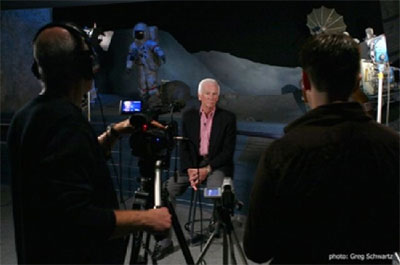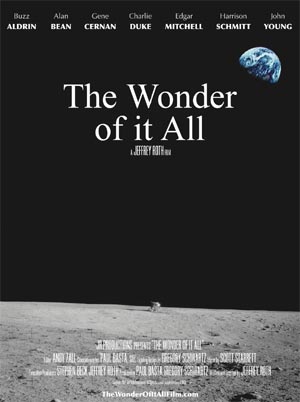Review: The Wonder of It Allby Ronald A. Wells
|
| A major thematic difference between Wonder and Shadow is that the former is more people-oriented, whereas the latter is more mission-oriented. |
A principal marketing difference is that Shadow already has a limited theatrical release. Wonder, which was also shot in high definition using a Sony camera that provided an HD, 1808i, 16:9 format, is still seeking distribution. Thus, the producers have several options available for circulation, including a theatrical release. It is currently being shown around the country at special presentations at science museums and similar venues, a few introduced by some of the Apollo astronauts. The film premiered at the Newport Beach Film Festival last April, and was also selected for viewing at the Worldfest Houston, Rhode Island, Edmonton, and Bergen International Film Festivals. It has already received multiple honors, among them a Remi Award. Although at present available to limited audiences, a DVD release of the movie is being planned, and the author was fortunate to be sent an advanced copy for review.
A major thematic difference between Wonder and Shadow is that the former is more people-oriented, whereas the latter is more mission-oriented. Shadow provides brief comments by ten of the Apollo astronauts in a round-robin “talking-heads” presentation led primarily by Michael Collins (Apollo 11 Command Module Pilot). Wonder also uses interleaved commentary from seven of the nine surviving Moonwalkers, but the editing has been done so skillfully that instead of seven individuals talking, it seems more like one—each of them often continues a sentence that the other started. The participants are: Buzz Aldrin, Al Bean, Gene Cernan, Charlie Duke, Ed Mitchell, Jack Schmitt, and John Young. Neil Armstrong apparently would have preferred more control over the interview format and was thus hesitant to contribute. After protracted discussions Dave Scott, however, refused to be included. Nevertheless, the relaxed manner in which all the interviews were conducted allowed the participating astronauts to speak more candidly on personal and philosophical matters than we have had the opportunity to hear before. The coherent editing into a seamless whole, including a well-balanced music and soundtrack, thus holds the viewer spellbound throughout. Even the astronauts themselves were impressed with the results.
They speak to us about private matters related to growing up, their education, their military training (or in the case of Jack Schmitt, his scientific study and field training), illustrated with personal photos. They also talk about how they dealt with their fame after their missions concluded, and how they look at it today. The astronauts also attempt to answer the age-old question: “What was it like to walk on the Moon?” The DVD, however, lasts an all-too-brief 82 minutes. Paul Basta, the cinematographer of the project and one of the producers, recorded 14 hours of interviews. Thus, one would hope that at some point a boxed super edition of seven DVDs would be produced, one for each of the astronauts, containing more complete biographies with archival flashbacks. According to Paul, they do have such a project in mind as well as archiving the complete, unedited tapes for later historical research, possibly at a NASA center. More of the Al Bean interview is available from the Wonder website on a separate DVD as a human interest short subject. It treats Al’s occupation as an artist and how he produces paintings on lunar and other space themes.
 Gene Cernan, Commander of Apollo 17, during his interview for the documentary. (© Jeff Roth Productions, 2007) |
Even so, the present movie DVD will give audiences an appreciation of the quintessential American hero: people who came from a variety of almost ordinary backgrounds, participated successfully for a short time in their lives in a common endeavor, but a highly technical one, and then moved on to a different way of life, not dissimilar to the lives we lead ourselves. Indeed, the film shows that the astronauts’ careers have been very much like a rope unraveled at both ends, in which we can see the individual strands come together on one side and then go their separate ways again on the other. Wonder will certainly inspire kids of all ages with the feeling that any of them could become an astronaut and fly to the Moon. The film thus gives parents the opportunity to encourage their children to take a deeper educational interest in science and engineering. In fact, the next crew members who will fly Orion to the Moon are in high school or college right now, while those who go on to Mars are yet unborn, or might perhaps be in kindergarten.
| Each of the astronauts broaches very personal subjects, and in some cases the displayed emotion is quite palpable. |
Most of us don’t have the opportunity to have a personal one-on-one talk with any celebrity, let alone with someone who has walked on the Moon. How many times have you sat speaking with one at the airport or in a coffee shop? People scurry by on their mundane dash to some other place, unaware that the guy sitting next to you has been to the Moon. Or ridden in a taxi with one to the airport when he says to you: “While we were on the way back from the Moon…” You notice the taxi driver’s eyebrows arch up; and you smile inwardly because you know he has just thought: “Uh-oh! Another couple of weirdoes!” Wonder leaves the viewer with the same sense of awe which an encounter like that would bring, not only because you have been able to spend a few minutes alone with someone of such distinction, but also because he seems just like someone you know very well. That personal feeling is Wonder’s principal strength.
Each of the astronauts broaches very personal subjects, and in some cases the displayed emotion is quite palpable. For example, Buzz Aldrin tells us very touchingly about his inheriting problems with alcohol from both parents and about his mother’s suicide the year before his Moon flight. He escaped those problems, which manifested themselves after his mission, by devoting himself to the future of spaceflight. As a result, he wants to be remembered as a space futurist rather than as an aviator.
Gene Cernan, on the one hand, very forcefully tells us that he can take himself back to Taurus-Littrow in an instant, remembering the smallest detail like all their tracks, or where he wrote his daughter’s initials on the surface, or where he left the rover parked. On the other hand, with short pauses and on the verge of tears, he softly describes his last few steps before climbing up the ladder into the lunar module because he knows no one will be back for a long time. At film’s end, he depicts his experience as overpowering, and the description itself leaves vestiges of that power written all over his face as he gazes wistfully and silently at the Apollo 17 Command Module on display beside him. Any actor would have difficulties in convincingly portraying the raw emotions in these two scenes. In a sense, the former captures the entire Apollo period: 450,000 people of all walks of life working together, sacrificing families and sometimes themselves, to put these 12 men on the surface of the Moon, and in one last step off that surface, it is all over, all that work, all those sacrifices, and the program ends! In a single final step, more heartrending than Neil’s first step was exciting! No wonder Gene said that he wished he could freeze time at that instant! What a dénouement!
| This film is one of inspiration, of motivation, of the realization that what we did as a nation, we can do again by pulling together. |
On the question of religion, they each had differing views. Aldrin actually took a specially prepared communion “kit” with him, and when they landed safely administered it to himself, although listeners on Earth only heard him ask that each one should give thanks for the safe landing in their own special way. Cernan felt that it was more of a spiritual than religious experience. His meaning here was that he had obtained a feeling closer to God more directly than man-made religion can bring, evidenced by his statement that when he looked back to Earth from the lunar surface it was like sitting on God’s front porch looking home. Charlie Duke noted that during the Apollo program he put his career and work first rather than God, but that from this vantage point in time he wanted to be remembered as a man who knew God, who loved God, and who walked humbly before God. Al Bean summed it up by noting that the trip was a reinforcer—those who were religious before going to the Moon, were more so afterwards, those who were agnostic were more agnostic afterwards, and those who were atheistic, were more so after returning. Al additionally explained that for him his trip to the Moon also raised his appreciation for life on the Earth and has made him more satisfied with the life he has since led.
This film is one of inspiration, of motivation, of the realization that what we did as a nation, we can do again by pulling together. Jack Schmitt framed that point by noting that the answer to the question: “If we can go to the Moon, why can’t we ____________ (fill in the blank)?” is you can, if you have the right technology base and young men and women who are motivated enough to accomplish it. Gene Cernan also echoed the same sentiment when he said that the legacy of Apollo is that nothing is impossible. But John Young, the quietest and least excitable of the group, was also the most direct when he simply stated that he had expected that we would go on to build a permanent Moonbase and that the world would be better off today for it had we done so. It is perhaps refreshing to note that Young not only walked on the Moon, but he also played a role in the development of the space shuttle, and indeed served as commander of STS-1, the first shuttle orbital flight in April 1981. Still contributing to his earlier expectation in retirement, he is an advisor for the development of Orion, which will take us back to the Moon and on to Mars.
The team of Jeff Roth Productions has passionately produced a finely-crafted gem that gives us a true feeling of what these men, these Moonwalkers, are really like as human beings. More than that, the film imparts the feeling that few of us would hesitate to trade places with these pioneers so that we, too, could experience the wonder of it all.
